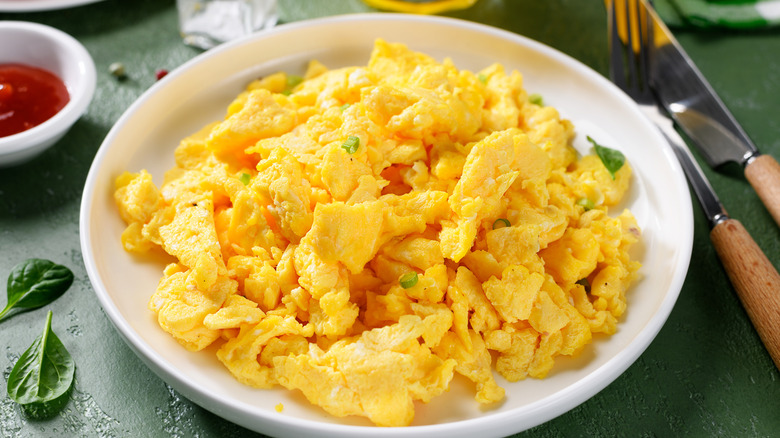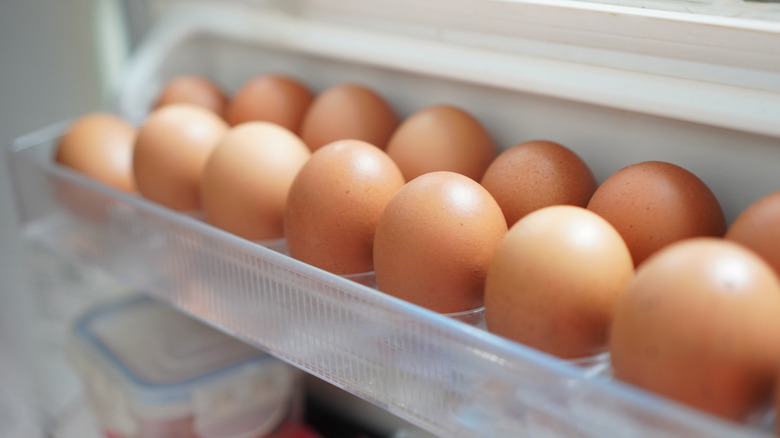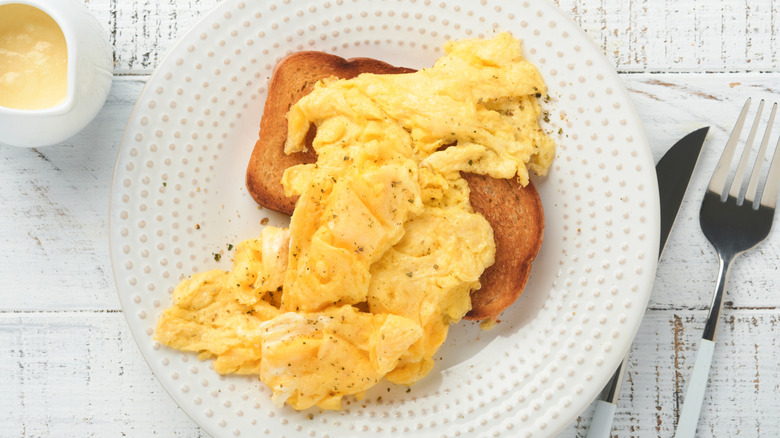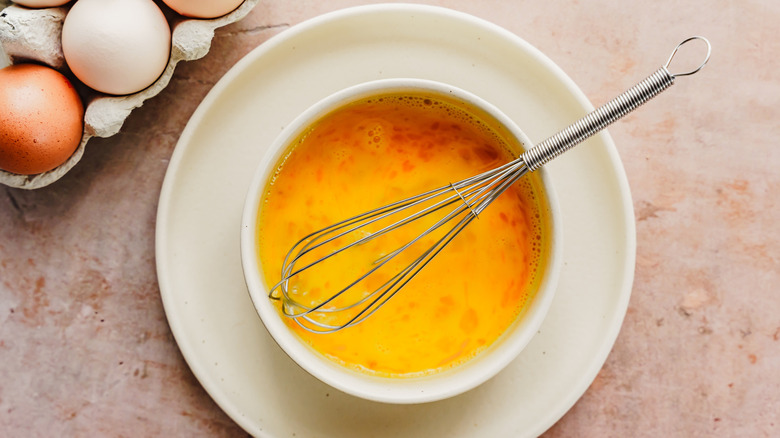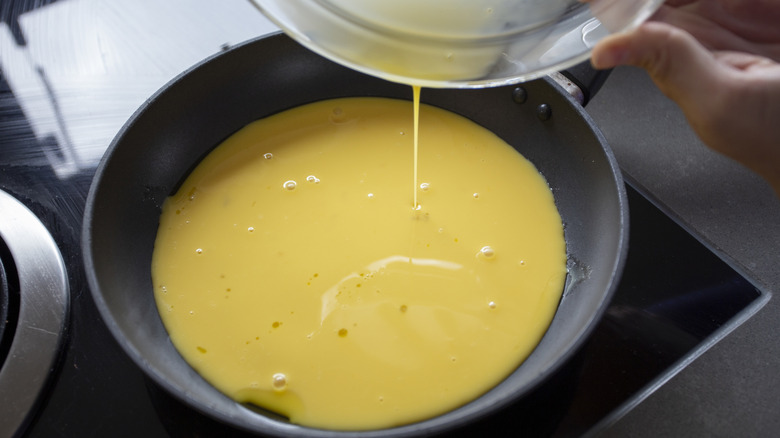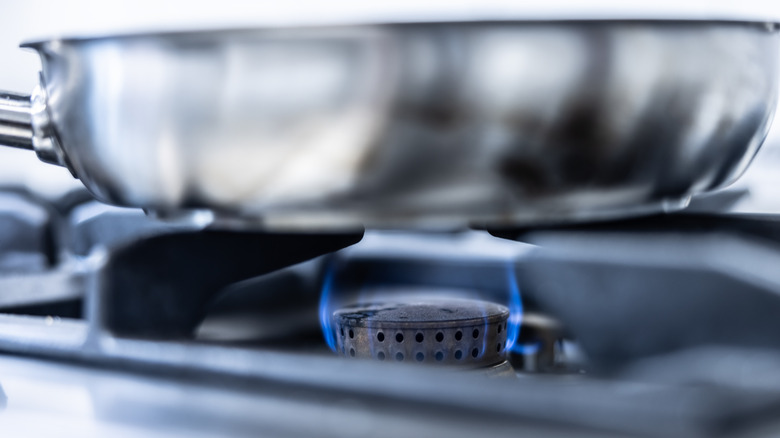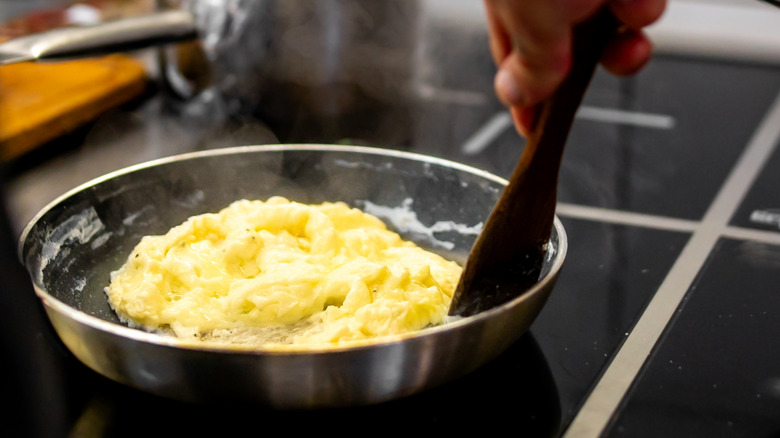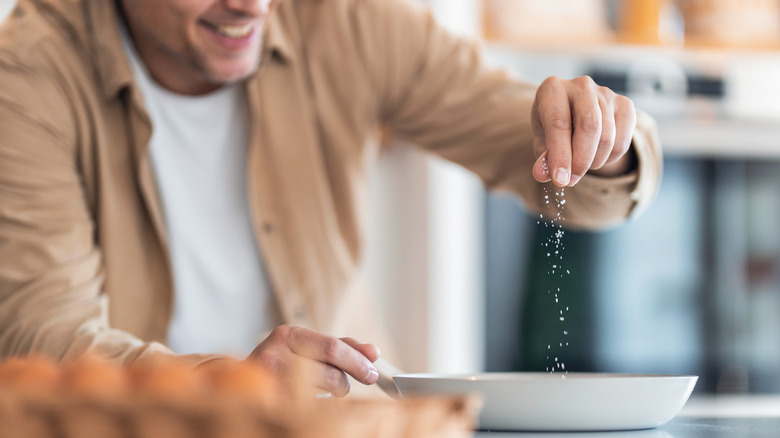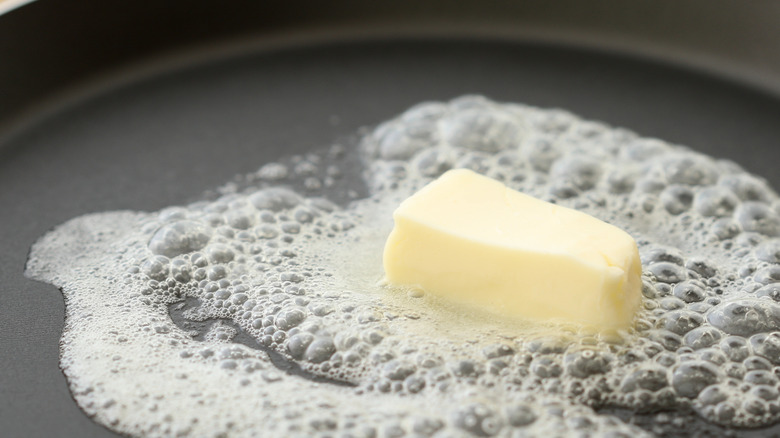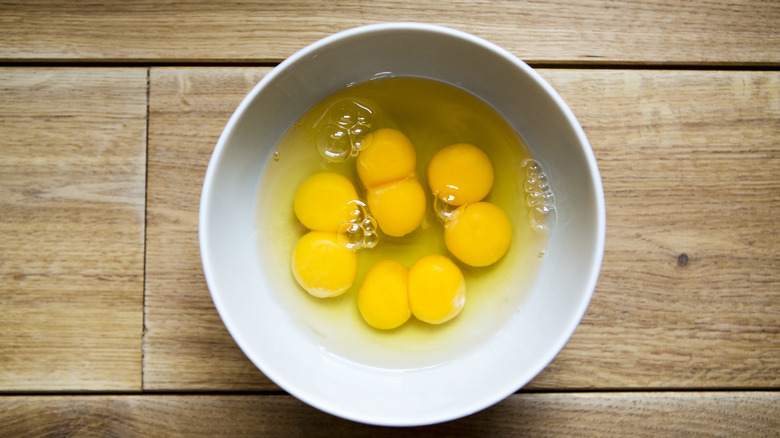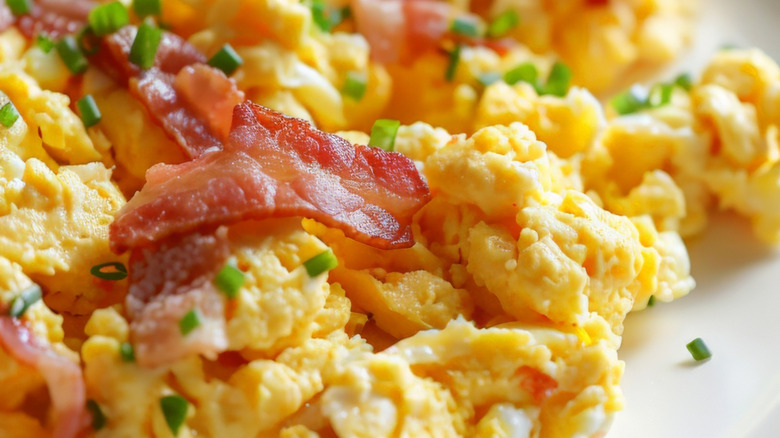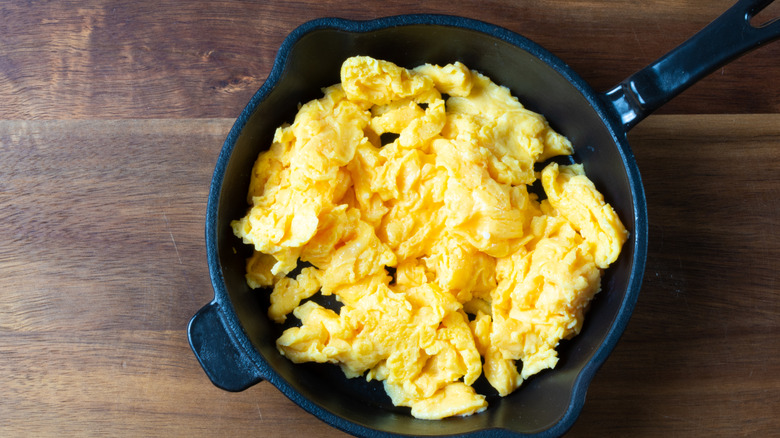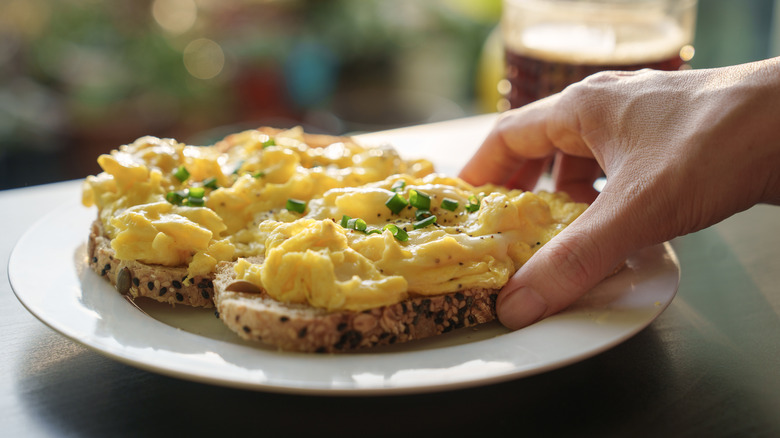Chefs Crack The Code On 12 Common Mistakes To Avoid When Making Scrambled Eggs
It's no surprise that scrambled eggs are a breakfast favorite for many people. Eggs are super versatile, full of protein, and best of all ... they're quick and easy to make. Even so, a handful of common cooking mistakes lead to less-than-ideal scrambled eggs. Anything from the temperature of the pan to when you incorporate seasonings to the type of dairy you use (or don't use) can drastically affect how scrambled eggs turn out. While they are a simple dish to make, the details truly offer a world of difference.
In an effort to discover some of the most common scrambled egg mistakes people make at home — and how to ensure you don't fall prey to them — I consulted three experts. Kyle Mendenhall, senior director of culinary innovation at Snooze A.M. Eatery, had lots to say about how to make perfect scrambled eggs. Chef Nelson Serrano-Bahri, director of innovation at the American Egg Board also weighed in on the matter. Lastly, Grace Vallo, founder, chef, and recipe creator for the food blog Tastefully Grace offered quite a few helpful insights that are sure to improve your technique. Keep reading to find out what they divulged so you can avoid typical mistakes moving forward and maintain complete control over your scrambled eggs from start to finish.
Using cold eggs straight from the fridge
The first step to making perfect scrambled eggs involves starting with room temperature eggs. According to expert Grace Vallo, founder, chef, and recipe creator for the food blog Tastefully Grace, using cold eggs is a mistake because they cook unevenly. To avoid this simple blunder and achieve more uniform results, she said you should let your eggs come to room temperature before you start cooking. Cold eggs also take longer to cook. So, if you can remember to bring your eggs to room temperature in advance, the benefits are twofold.
To bring eggs to room temperature, you have a couple options. First, simply take the eggs out of the fridge and leave them on the counter. Depending on how cold your fridge is, they should reach room temperature in about 30 minutes, maybe a little longer. If you're in a hurry, you can also place cold eggs in a bowl with warm water. In about five to 10 minutes they should be good to go. Just make sure the water isn't hot, as it can start cooking the eggs. To speed the process up even more, place the bowl in your sink under the tap with a slow trickle of warm water dripping over the top. Whichever method you choose, you'll know the eggs are ready for scrambling when they are no longer cold to the touch.
Not adding water for the fluffiest scrambled eggs
People have a lot of preferences when it comes to scrambled eggs. Some like them super fluffy, and others prefer a denser, creamier texture. If you're part of the camp that hails fluffy scrambled eggs, not adding a touch of water to the mix is a mistake. According to chef Nelson Serrano-Bahri, director of innovation at the American Egg Board, "Water is key for fluffy scrambled eggs! Adding a splash of water to your beaten eggs creates steam during cooking, which expands the eggs and makes them fluffier. Water also evaporates quickly, creating pockets of steam that lift the eggs as they cook." He suggests adding 1 teaspoon of water per egg.
And Kyle Mendenhall, director of culinary innovation at Snooze A.M. Eatery, told me milk can also be used to create fluffier scrambled eggs. When you compare the two liquids, water leads to the fluffiest scrambled eggs – but either way, a dash of milk or water goes a long way. He said the added moisture helps prevent the eggs from curdling too fast. He also said, "Some chefs will caution you against adding water or dairy products to your eggs for various reasons (the water may make them too runny, the milk may compromise the flavor, etc.). But these additives can actually make your scrambled eggs more moist and light." The key is using the correct amount of liquid, which he said is 1 tablespoon per egg.
Not whisking enough or waiting to whisk in the pan
Ensuring your eggs are properly whisked is another key step to making perfect scrambled eggs. According to the director of culinary innovation at Snooze A.M. Eatery, Kyle Mendenhall, "A common mistake that leads to dense, less fluffy scrambled eggs is that the raw eggs (yolk and white) are not mixed together enough before cooking." He noted the yolk and whites cook differently so it's important to make sure they are thoroughly combined before cooking.
To avoid under-whisking eggs, the experts recommend beating them with a fork for about one minute (or until they are frothy) before pouring them into the pan. Mendenhall likes to use chopsticks, but whisking eggs with a fork is the most common tool used to achieve the ideal aerated, thoroughly combined texture. Obviously, a whisk works too, but forks are so much easier to clean and since they work just as well, many cooks reach for a fork. If those tools don't speak to you or you want to try something different, put your raw eggs in a mason jar and shake vigorously to achieve a similar result. Whatever tool you decide on, a proper "whisk" is essential in achieving an even cook and fluffy scrambled eggs.
Using the wrong type of pan or forgetting to grease it before adding eggs
The pan you use to make scrambled eggs is also important. If you use the wrong pan, it can be tricky to maintain control over them while they cook ... or lead to the eggs sticking. Chef Nelson Serrano-Bahri, director of innovation at the American Egg Board, told me that a non-stick skillet is the way to go because the eggs won't require an excessive amount of fat (you still want a bit of butter or oil). Plus, they won't stick to the pan so you can easily stir them while they cook.
Grace Vallo, Tastefully Grace, agrees with chef Serrano-Bahri and added that sticky or extra large pans make it difficult to control scrambled eggs while cooking, so use a small one instead. She also noted that you should always preheat your pan and grease it with oil or butter before pouring the eggs into the pan. That way, you ensure they don't stick and you can easily manipulate them while they cook, which is another essential step in the cooking process.
Cooking scrambled eggs on too high heat
Another common way that people mess up their scrambled eggs is by cooking them at a super high temperature. You may think this will get scrambled eggs on your plate faster, but really, it just leads to overcooked, dry eggs with a less-than-ideal, rubbery texture. To avoid this blunder, Grace Vallo, Tastefully Grace, said you should cook scrambled eggs slowly, on low or medium heat to ensure they stay soft and creamy.
And the American Egg Board's Nelson Serrano-Bahri confirmed what Vallo told me: "It can be easy to overcook scrambled eggs. Cooking scrambled eggs on low heat allows them to cook slowly and gently, preventing overcooking to maintain their moisture." So, while it may be tempting to crank up the heat when you are in a rush, it isn't your best bet. After all, no one prefers dry, rubbery scrambled eggs. Be patient and you'll be rewarded with the soft, creamy texture we all know and love.
Not stirring scrambled eggs enough while they cook
Once you pour your thoroughly-whisked eggs into a preheated pan, you still want to pay close attention while they cook. I'm not just talking about watching them either — the experts agree you should continue stirring while they cook. In fact, Grace Vallo, Tastefully Grace, said leaving them to sit in the pan creates large dry curds, which are far from ideal.
According to chef Nelson Serrano-Bahri, director of innovation at the American Egg Board, "Continuous and gentle stirring while cooking scrambled eggs prevents large curds from forming and results in evenly cooked scrambled eggs." He and Vallo recommend using a rubber spatula to stir and push the eggs around while they cook. This helps achieve soft folds and smaller curds.
And Snooze A.M. Eatery's Kyle Mendenhall said, "In addition, constantly stirring the eggs throughout the cooking process will help make the eggs lighter as you incorporate air. The continued mixing as you are cooking will also create smaller 'curds' of cooked egg. The smaller the curd is, the lighter the texture will be when eating." Smaller curds are created with rapid stirring and larger curds are the result of slower agitation in the pan. If you are a big fan of fluffy, light eggs, keep that spatula moving while your eggs cook — you'll be glad you did.
Incorporating salt at the wrong time or not adding enough of it
Bland scrambled eggs are more common than you might think, so it's important you not only season them, but you need to sprinkle seasoning at the right time. Otherwise, the flavor lacks and you might even make the eggs watery. Chef Nelson Serrano-Bahri explained you want to add salt right before they are done cooking: "Adding salt at the end of cooking your scrambled eggs keeps the eggs fluffy by reducing the chance of drawing out moisture from the eggs too early, which can make them watery," he said. Instead, Serrano-Bahri recommends adding a pinch of salt and any other seasonings you might like when the eggs are almost fully set and ready to enjoy.
Grace Vallo, founder, chef, and recipe creator for the food blog Tastefully Grace, confirmed that under-seasoned scrambled eggs are a common mistake. To ensure you don't have to suffer through bland, yucky eggs, she urges you to taste and adjust the seasonings as needed. Don't just give them a light sprinkling and consider it good. Once you add what you think is the appropriate amount of salt and other seasonings, give the eggs a small taste test and adjust accordingly before serving. Also, start by adding your seasonings slowly — you can always sprinkle on more.
Adding too much milk or opting for milk instead of butter
Using too much liquid in your scrambled eggs, whether milk or water, is a recipe for disaster. Too much liquid makes scrambled eggs runny and, as it turns out, this is pretty easy to do. So, instead of using milk, two of our experts recommend swapping it out for butter. "Using butter instead of milk adds fat without introducing additional liquid and reduces the likelihood of a watery scramble," said chef Nelson Serrano-Bahri. And, of course, he also noted butter not only promotes a smoother scramble, but it enhances flavor significantly — and he likes to melt a small amount of butter in the frying pan before adding eggs.
Grace Vallo, founder, chef, and recipe creator, also likes to use melted butter in her scrambled eggs. She told me a 3:1 ratio of eggs to butter is ideal. Basically, if you're scrambling three eggs, 1 tablespoon of melted butter should be added to the pan. This ratio is perfect for creating extra soft and fluffy scrambled eggs. Plus, the infusion of butter leads to a richer taste. Yum!
Opting for egg white only scrambled eggs
Egg white only scrambled eggs are popular in some circles because they're viewed as a healthier option. While it is true that egg white only scrambles contain fewer calories and fat than when you make the dish with the yolks included, fat in the yolks is actually what leads to the richest flavor and texture possible. If your main priority is limiting fat and calories, egg white only scrambles aren't completely off the table, but they pale in comparison to the real deal.
The American Egg Board's Nelson Serrano-Bahri goes so far as to say you should add extra egg yolks to your scramble. The chef said, "Separate a few extra egg yolks and mix them into the whole eggs before cooking your scrambled eggs!" He told me that the extra fat you get from additional yolks contributes "a richer texture and provides more emulsification to trap air." As a result, you get fluffier scrambled eggs in the end. Pair the extra yolks with butter or a splash of water and you'll have the fluffiest, tastiest, most flavorful scrambled eggs around.
Forgetting about tasty add-ins
A basic scrambled egg recipe is more than sufficient, but sometimes you need to switch things up a bit to keep the dish interesting. When you're in the mood for a boost of flavor and something different, tasty add-ins are your friend. Anything from cheese to herbs to sour cream to maple syrup and beyond makes a wonderful addition to scrambled eggs. You can even sprinkle scrambled eggs with bread crumbs for a crispy finish.
In addition to forgetting about tasty add-ins, incorporating extra ingredients at the wrong time is also a mistake. Chef Nelson Serrano-Bahri, director of innovation at the American Egg Board told me, "Adding cheese to your scramble too early can result in the cheese burning. I recommend adding soft cheeses, like goat cheese, to a temperature of 165 degrees Fahrenheit for about one to two minutes before you plan to take them off the heat." With harder cheeses, like cheddar, Serrano-Bahri recommends adding at the midway point. He also likes to upgrade scrambled eggs with extra dairy. He said ingredients like sour cream or crème fraîche lead to a velvety texture people love.
Grace Vallo, chef behind the food blog Tastefully Grace, also noted timing is key with add-ins. To avoid an undesirable texture, she adds mix-ins about one minute into the cooking process. However, if you're talking about herbs, chefs are less picky — Vallo told me they can be added to whisked eggs before they go in the pan.
Leaving scrambled eggs in the pan for too long
Okay, so let's say you manage to get all the ingredients mixed and added at the right time, there's still a fatal, common mistake that can easily ruin all of your hard work: Overcooking scrambled eggs. Unfortunately, it's a lot easier than you might think. "Overcooked scrambled eggs will have a firm texture and some bounce to their bite," said Kyle Mendenhall, director of culinary innovation at Snooze A.M. Eatery. They may even become dry and crumbly — and no one wants to describe their eggs as dry and crumbly.
Mendenhall added, "You should remove the eggs from the heat 'one level' below where you want them to finish on your 'done-ness' scale." This allows the residual heat in the pan to finish cooking your eggs without the threat of overcooking them by mistake. He also said it's no big deal to remove your eggs from the heat even if they look a bit runny — because the heated pan will finish them up perfectly.
Chef Nelson Serrano-Bahri agrees with Mendenhall and confirmed that removing scrambled eggs from heat when they are still slightly runny is ideal. However, he also noted the residual heat in the pan could take scrambled eggs past the perfect level of done-ness. And so, Serrano-Bahri recommends transferring eggs to a plate as soon as you remove them from heat to ensure they don't dry out.
Not eating scrambled eggs immediately
Once your delicious, fluffy scrambled eggs are cooked just right, it is important you serve and enjoy them straight away. Grace Vallo, founder, chef, and recipe creator for Tastefully Grace, said a big mistake people fall prey to is making scrambled eggs too early. You want to plan it so they aren't done before the rest of the menu. If you don't, they start to lose some of their yummy texture quickly. Plus, they cool down fairly fast as well, and cold scrambled eggs are not the greatest.
To avoid this common mistake, make sure your scrambled eggs are the last item to finish cooking. Then, remove from the heat and serve immediately. If you can manage to bring all the elements of your meal together at the same time and not leave your eggs to cool before enjoying, you get to savor them at their very best. Plus, who wants all their effort to go to waste at the very last possible moment?
As you can see, there are plenty of common mistakes you should avoid when making scrambled eggs at home. However, if you follow our experts' advice, you'll achieve restaurant-worthy scrambled eggs. Or, at the very least, you'll be making them similar to the pros — and when it comes to food, there's no better way to impress than by mirroring what the experts do.

